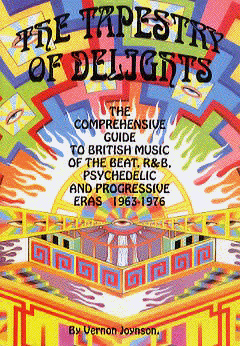 The Tapestry Of Delights: The Comprehensive Guide To
British Music Of The Beat, R&B, Psychedelic And Progressive Eras 1963-1976
by Vernon Joynson (Borderline Productions, £27.50
PBK)
The Tapestry Of Delights: The Comprehensive Guide To
British Music Of The Beat, R&B, Psychedelic And Progressive Eras 1963-1976
by Vernon Joynson (Borderline Productions, £27.50
PBK) The Tapestry Of Delights: The Comprehensive Guide To
British Music Of The Beat, R&B, Psychedelic And Progressive Eras 1963-1976
by Vernon Joynson (Borderline Productions, £27.50
PBK)
The Tapestry Of Delights: The Comprehensive Guide To
British Music Of The Beat, R&B, Psychedelic And Progressive Eras 1963-1976
by Vernon Joynson (Borderline Productions, £27.50
PBK)
The Tapestry Of Delights is a revelation. One of its principal purposes: "To bring to your attention many artists who didn't attract the publicity and acclaim they deserved first time around." Indeed, as Vernon Joynson rightly claims, many of these artists have never before appeared in an encyclopedia. From Bent Frame ("A very obscure group") to David Bowie; from Two's Company ("A forgotten pop duo.") to Traffic; virtually every Tom, Dick & Harriet who stood in front of a microphone from 63 - 76, and then put out a piece of vinyl to celebrate the fact, are in here, regardless of alleged 'merit'. The hilarious tale of talentless, flower-power popsters, John's Children, their entrepreneurial producer and the ill-fated Orgasm album ("which still sounds like one of the worst albums ever recorded.") is the stuff of which spoof documentaries are woven; they even command more space in the Guide than Rod Stewart!
Yes, this is a book as much concerned with the sometimes shitty underdog as the strutting superstar - their discographies and their ever-changing personnel logged in loving detail. Haverson Apricot, Humpy Bong, and the deliriously surreal Crocheted Doughnut Ring - forgotten names to conjure with. At the tapestry's edge you'll even find the avant-garde likes of AMM, SME, Keith Tippett Group and Howard Riley, who all recorded for major labels early in their careers.
The lucid commentary by Vernon Joynson and his team of collaborators is usually shrewd and fair-minded, though I strongly disagree with their negative conclusions on Ginger Baker's two Airforce albums (about time they were reissued on CD!) and Jethro Tull's Thick As A Brick and A Passion Play. It's also largely untainted by 90s' cynicism and jocularity and, happily, free from nostalgic yearning; instead, preferring to stimulate interest, especially in the little-known, by considering their efforts - however naive or pompous they may now seem - within the context of the zeitgeist that engendered them.
That profusion of styles (r'n'b, folk, psychedelic, hard rock, jazz, ethnic, classical, improv) which converged within the still vilified late 60s to mid-70s progressive rock genre, is particularly appealing; here, the archivist's torchbeam reveals a scattering of neglected, innovative British groups (including Comus, Gryphon, High Tide, Third Ear Band) who were just as interesting as the Krautrockers who are currently enjoying a huge critical revival (much of it opportunistic and market orientated - the true diehards know who they are!). But the British progsters' time will come again. . .
This book also functions as a collectors' guide, providing information on the approximate price, availability (including CD reissues) and merit of rare albums and singles. And there's plenty of photographs of record covers to bring back memories of groovier times. If the price tag seems rather hefty for a paperback encyclopedia, consider the detail and astonishing scope of the research contained therein - a great deal of which you won't find anywhere else. The Tapestry Of Delights is, quite simply, the most compelling encyclopedia around. Its cross-referencing system will have you journeying avidly through the labyrinthine highways and byways of yesteryear. (Chris Blackford)
Borderline Productions, P.O. Box 93, Telford TF1 1UE, England
This review was first published in Rubberneck 22, June 1996
© Rubberneck